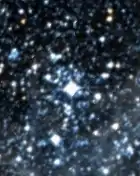 | |
| Observation data Epoch J2000 Equinox J2000 | |
|---|---|
| Constellation | Dorado |
| Right ascension | 04h 55m 11.08594s[1] |
| Declination | −67° 10′ 10.4091″[1] |
| Apparent magnitude (V) | 9.715[2] |
| Characteristics | |
| Spectral type | B9Iae[3] |
| U−B color index | −0.67[4] |
| B−V color index | +0.10[4] |
| Astrometry | |
| Radial velocity (Rv) | 314[3] km/s |
| Proper motion (μ) | RA: -1.3[3] mas/yr Dec.: -0.1[3] mas/yr |
| Distance | 2034 ly (624[3] pc) |
| Absolute magnitude (MV) | −9.77[4] |
| Details | |
| Mass | 58[4] M☉ |
| Radius | 285[4] R☉ |
| Surface gravity (log g) | 1.29[4] cgs |
| Age | 1,000,000[4] years |
| Other designations | |
| Database references | |
| SIMBAD | data |
HD 32034 (or R 62) is one of seven blue hypergiants in the Large Magellanic Cloud and is suspected to be a shell star.[3][4][5] It lies within the loose association of stars designated NGC 1747.
References
- 1 2 Brown, A. G. A.; et al. (Gaia collaboration) (August 2018). "Gaia Data Release 2: Summary of the contents and survey properties". Astronomy & Astrophysics. 616. A1. arXiv:1804.09365. Bibcode:2018A&A...616A...1G. doi:10.1051/0004-6361/201833051. Gaia DR2 record for this source at VizieR.
- ↑ Høg, E.; et al. (2000). "The Tycho-2 catalogue of the 2.5 million brightest stars". Astronomy and Astrophysics. 355: L27–L30. Bibcode:2000A&A...355L..27H.
- 1 2 3 4 5 6 "HD 32034". SIMBAD. Retrieved 27 December 2021.
- 1 2 3 4 5 6 7 8 Przybylski, Andrew K. (1 April 1971). "The analysis of the spectrum of the Large Magellanic Cloud supergiant HD 32034". Monthly Notices of the Royal Astronomical Society. 152 (2): 197–208. Bibcode:1971MNRAS.152..197P. doi:10.1093/mnras/152.2.197.
- ↑ United States Naval Observatory (28 August 2016). Publications of the United States Naval Observatory (2 ed.). Wentworth Press. p. 178. ISBN 978-1-372-34130-4.
This article is issued from Wikipedia. The text is licensed under Creative Commons - Attribution - Sharealike. Additional terms may apply for the media files.